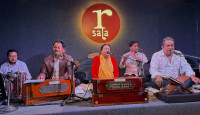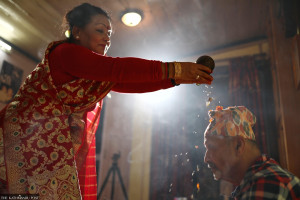Culture & Lifestyle
Promotional praise over honest reviews hampers literary growth
Literary critic and editor Raj Kumar Baniya highlights how personal connections often outweigh merit in giving of Nepali literary awards.
Sanskriti Pokharel
Raj Kumar Baniya has over two decades of experience in journalism. A passionate reader, his analytical articles and reports on Nepali literature are widely read.
In this conversation with the Post’s Sanskriti Pokharel, Baniya discusses the stagnation of Nepali literature, publishers’ negligence and how personal connections often outweigh merit in Nepali literary awards.
Are Nepali writers pushing boundaries with form, language, and storytelling, or are they sticking to safe and traditional narratives?
Only a few authors represent their era. These authors experiment and innovate in terms of subject matter, language, craft, and narration, illuminating the entire literary scene. However, most writers are driven by whims rather than a purpose.
Nepali writers, unfortunately, have yet to break free from their ‘comfort zone’. The literary landscape is largely shaped by imitations of imitations rather than original creations. There is a noticeable lack of confidence in exploring new literary themes, techniques, and perspectives.
Writers often hesitate, uncertain if their themes will be read, appreciated, or rewarded, leading to stagnation. This raises a crucial question: should the writer follow or lead the reader?
How would you compare the younger generation of writers with the older generation?
We don’t have a tradition of fully embracing new writers. It would be unjust to say that they haven't contributed anything. With many new writers emerging, there may be a tendency to believe that the older ones are superior to the newcomers.
The passage of time and the rapid advancement of technology have made writing literature difficult for both established and emerging writers. In comparison, earlier writers put in great effort and deep study. They approached literature as a passion, while today’s writers often see it as a career. As a result, exceptional works are rare, and often, there is a sense of something lacking—an emptiness or incompleteness.
Has Nepali literature continued to reflect cultural and societal themes in recent years, or has it taken new directions?
The strength of Nepali society lies in its multi-ethnic, multilingual, and multicultural identity, which is increasingly reflected in contemporary literature. Themes such as specific traditions, history, culture, civilisation, environment, and rituals are explored in fiction, non-fiction, and poetry.
New and innovative words have enriched the Nepali language, and writers are delving into society to uncover historical, social, and cultural narratives. While there may be gaps in craftsmanship, this awareness is commendable.
Recently, there has been a trend where groups of writers publicise each other’s books as good, regardless of their quality. What are your thoughts on this?
Yes, Nepali literature is teeming with noise and chatter. Even the year’s booklists seem to be selected based on hype. The readability of many of these books is extremely weak—sometimes, it feels better to leave the pages untouched.
Just like there is factionalism in politics, it is even more intense in literature. Writers are divided into different groups. There is a rush to grab a book from a member of your group and post it on social media, giving it the red seal of excellence. If there is a literary faction, it should be for the promotion of good literature. But here, it is completely sponsored. This confuses or deceives readers, leading to a parroted chorus of “good, good, good” and “amazing, amazing, amazing” regardless of the book’s quality.
Many Nepali books are accused of being poorly edited. Is this a reflection of the publishing industry’s negligence, or are writers failing to take their craft seriously?
The reality is that there’s hardly any editing in books these days. It often only involves correcting minor spelling mistakes, as we have language editors but not content editors. The carelessness is so widespread that by the time the manuscript reaches the editor, the author and publisher have already set the book launch date.
Publishers are reluctant to invest in editing. As a result, editors do not receive proper compensation or sufficient time, leading to subpar books. Collaboration between authors and editors is rare, and all three—authors, publishers, and editors—share responsibility for books failing to reach perfection.
How do you manage the pressure of offering an honest critique as a book reviewer, especially when it could upset a prominent writer or publisher?
Honestly, nobody here wants critiques. Criticism is seen as opposition or defamation. Authors and publishers often aim to get free advertisements for mediocre books from prominent critics. Before the book launch event, they whisper, “Our in-laws are here today; please don’t say anything negative.” What authors and publishers want is not a critic but a marketing officer. As a result, even poorly written books are adorned with flowery words and called exceptional. Honest criticism is nearly impossible because even light critiques are perceived as attacks. I refrain from reviewing in such an environment.
Do you think literary awards in Nepal are often influenced by connections rather than merit?
Nepal has an excessive number of literary awards compared to other fields. Some writers are practically buried under awards. Except for a few, the absence of most of these awards would not harm Nepali literature. They are often distributed to the least mediocre books based more on personal connections than on merit. This is why it’s often predictable who will receive an award. It’s the same people repeatedly receiving them. The irony is that no one knows who receives the government awards, while private sector awards generate more noise and controversy.
Raj Kumar Baniya’s book recommendations
Antarmanko Yatra
Author: Jagadish Ghimire
Publisher: Book Hill
Year: 2008
This book is about self-discovery and understanding death. It also describes the ups and downs of life.
Mokshanta: Kathmandu Fever
Author: Kumar Nagarkoti
Publisher: Book Hill
Year: 2011
This collection of off-beat stories, written by Nagarkoti, has given Nepali readers a wonderful taste of surrealism.
Mrityu-Kavita
Author: Manjul
Publisher: Sajha Prakashan
Year: 2012
Manjul argues that understanding life requires an awareness of death. I enjoyed the book’s philosophical ideas.
Raniban
Author: Krishna Gautam
Publisher: Sangrila Publication
Year: 2017
Gautam writes about the changing views of the new generation. It captures people’s shifting tastes and interests.
Sandhya Samrachana
Author: Yogesh Raj
Publisher: Martin Chautari
Year: 2013
This read delves deep into the Hindu Newa society and discusses mortality in a wonderful way.




 17.12°C Kathmandu
17.12°C Kathmandu














